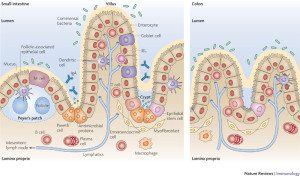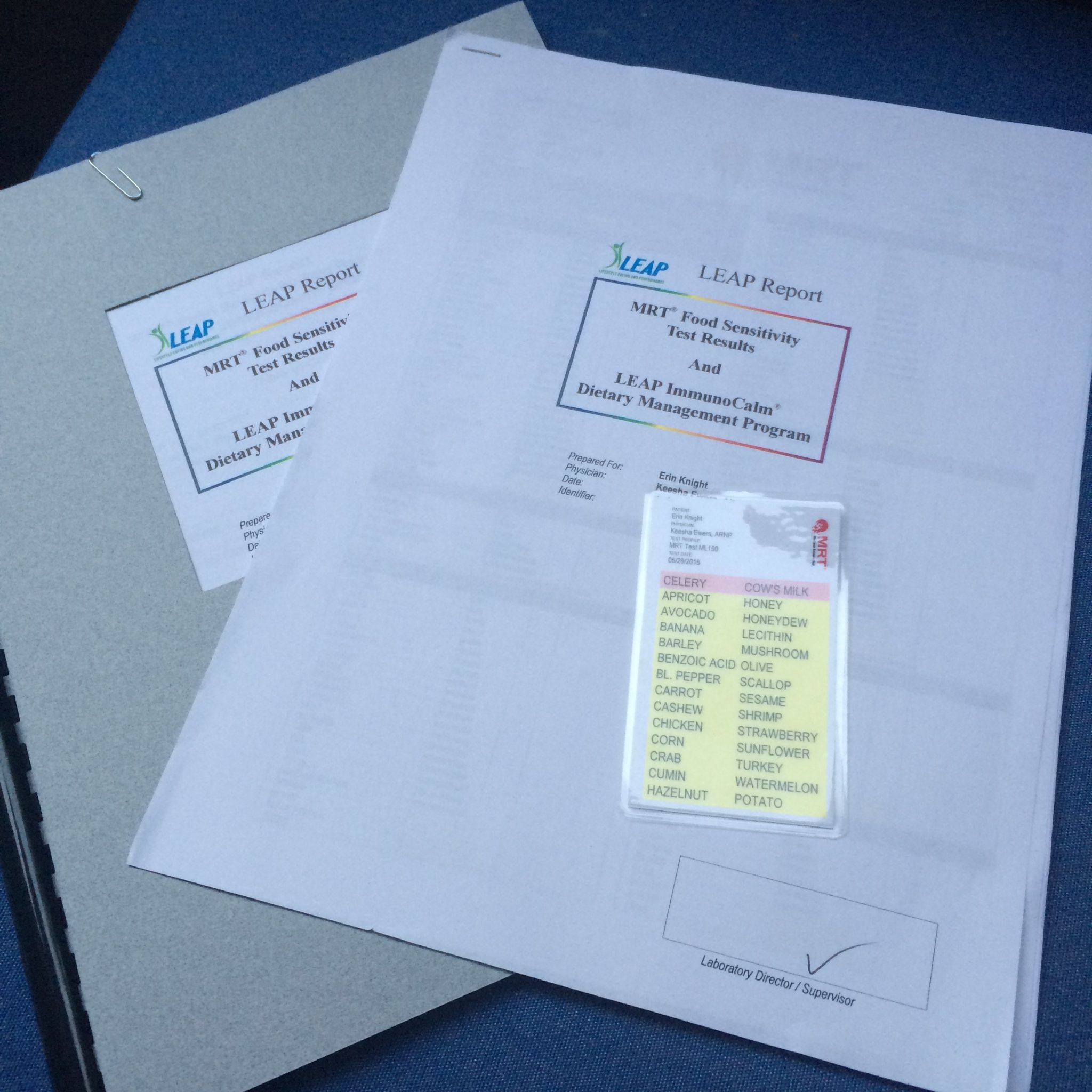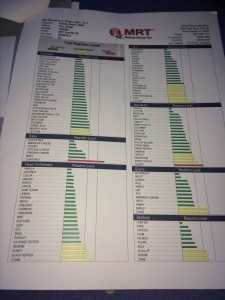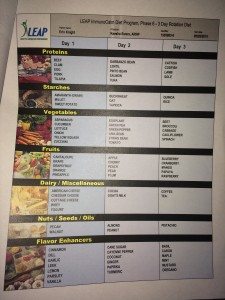With all the talk about food sensitivities and food allergies being on the rise and apparently the source of all evil symptoms (not quite the whole truth, but more on that later), you may be wondering if you should get a food sensitivity test to see if a food reaction is responsible for your skin rashes, migraine headaches, achy joints, etc.
Maybe you are worried it will be overwhelming or require too much change and effort. (It does require some effort, but with the right support and an open mind you’ll discover all kinds of cool new foods to fill the gaps of the old standbys).
Maybe you know it would be a good idea, but just aren’t sure what you’d be getting yourself into yet.
Having just gotten my fourth test back this week, I thought I’d share a little bit about the experience from a consumer point-of-view.
I got my first test done about a year after going gluten-free, when I was starting to feel a little better but still not well (or radiant) by any stretch of the imagination. The LEAP MRT food sensitivity test detects immune reactions to 150 different foods.
 Each food is ranked as green, yellow or red with regards to how bad your reaction is. You start by eating only the least reactive foods, and slowly reintroducing the other “ok” foods, avoiding the worst foods for a couple months.
Each food is ranked as green, yellow or red with regards to how bad your reaction is. You start by eating only the least reactive foods, and slowly reintroducing the other “ok” foods, avoiding the worst foods for a couple months.
In my first test in July 2013, there were only about 5 or 6 foods that were on the green (low reactivity) list! I remember feeling stunned staring at the sheet that told me I could eat just beef, cabbage, yellow squash (not green squash!), coconut and tapioca for two weeks or so before introducing other foods like olives, broccoli and hazelnuts.
I had done SO much damage by not identifying and stopping my gut inflammation and reactions to wheat for over ~14 months, that a full year into the gluten- and dairy-free diet and a light gut-healing protocol I still had such a leaky gut that I was reactive to almost every food.
 This is when I entered a very experimental phase of trying new foods that I hopefully wasn’t sensitive to yet like squid, crab and smoked oysters. You see, you TEND to see the highest red scores for foods you eat frequently because they have a higher chance of sneaking through the leaky epithelium and clashing with your immune system. This isn’t a hard and fast rule. I’ve had a few oddball items show up like honeydew mellon or turkey, which I very rarely if ever eat and then knock on wood I’ve never had an issue with eggs or salmon, which I eat all the time.
This is when I entered a very experimental phase of trying new foods that I hopefully wasn’t sensitive to yet like squid, crab and smoked oysters. You see, you TEND to see the highest red scores for foods you eat frequently because they have a higher chance of sneaking through the leaky epithelium and clashing with your immune system. This isn’t a hard and fast rule. I’ve had a few oddball items show up like honeydew mellon or turkey, which I very rarely if ever eat and then knock on wood I’ve never had an issue with eggs or salmon, which I eat all the time.
The unpredictability of what is going to show up on the results is what makes testing worth it to me. The other way to go about this process is to do an elimination diet where you avoid the top common allergens and basically all of the foods you usually eat. For example, if you always eat oatmeal with apples for breakfast, you would swap that out for quinoa and pears for a couple of weeks before reintroducing first apples and then oatmeal and watching for reactions.
Although the elimination diet method is very reliable, if you are in-tune with your body and perhaps use heart rate monitoring after meals to help notice more subtle reactions, I find this process is a bit tedious and time consuming for most people. With the blood test, you get the results back in a couple of weeks and can just get right on with the healing process.
So, back to the test results… You receive a card listing all your reactive foods, a chart showing ranking the different foods on a scale of reactivity and a binder with more information on how to start the diet and more info on some of the weird “additives” like lecithin or benzoic acid that may show up.
Here is a photo of the results by category (protein, grain, etc) and reactivity. Phase 1 of the diet avoids all yellow and red and introduces the greens starting with the least reactive.
This photo shows the suggested re-introduction schedule that they send you where they pick off the absolute least reactive green foods and have you eat those for about a week before introducing any new foods from the next group (one at a time).
After all the green foods are re-introduced (they say a month, but if you really go one at a time I think it can take a little longer), you start phase 2- the rotation diet. The LEAP company sends you a suggested rotation diet with a couple of foods from each category split across 3 days.
A rotation diet is CRITICAL for giving your immune system a break, while you work to heal the gut and prevent a continuous cycle of new food sensitivities (more on this). Still, I never found this phase two hand-out very helpful for 3 reasons:
1. They do keep cows milk and cow’s cheese on the same day and very obvious matches like that, but they don’t do a good job separating food families (for example, melon and zucchini are both in the gourd family and technically should be rotated together as would quinoa and beets, rhubarb and buckwheat and other not too familiar cousins).
2. If there are enough foods to choose from, a 4-day rotation is better than a 3-day rotation to give your immune system a sufficient chance to recover from any particular food between exposures.
3. This chart is generated by a computer program and not someone who cooks or enjoys eating. I prefer to match up foods that go together in familiar recipes, like tomatoes and basil or corn and avocado (chips and guacamole, hello?)
As a result, I came up with more creative ways to keep track of the food families and the rotation that I share with my FDN clients when they are going through the rotation diet phase. Compliance with rotation diets is typically only between 20-40% (not too surprising when you are faced with the menu of “millet, codfish, grapefruit and pistachio” – sounds like a bad episode of FoodNetwork’s CHOPPED). When we work together to customize a set of tools that will really make this work for you and your household, we set you up for a successful rotation diet!
As I hinted up top, there is more to solving a leaky gut than identifying and avoiding food sensitivities. While it is a vital component, it is also paramount to be on a gut-healing protocol at the same time.
The first test I took only had a handful of safe, green foods. But I was happy to have found a significant root cause of my pain and inflammation.
The second test, was mostly green foods! This was such a relief, because it meant that I was moving in the right direction, healing my gut and less foods were flaring my immune system.
My latest test just has two red foods (cow’s milk and celery) and a handful of yellow foods. Considering that I had several run-ins with contaminated water and gluten during my recent 5-month stint in SE Asia and a steady hotel-breakfast-diet of eggs and the same fresh juices (including celery) I am grateful it isn’t a longer list! The journey continues!
Now that you have heard my story about running the LEAP MRT four times, what questions do you have? Shoot me an email at erin@engineeringradiance.com and leave a comment below with either a question or your personal experience with food sensitivity testing.
Tried everything and still getting migraines?
A trained Migraine Freedom™ Coach can help!








This is interesting! I never got a food sensitivity test done but now I would like to. Thank you for sharing this information.
I have a friend who had a food sensitivity test done. She was getting sick, and she couldn’t figure out why. It turns out, she had several issues with various foods.
I am sorry to hear that your friend was having a hard time. Feel free to contact us if she need any help. – Julie C
I didn’t know much about food sensitivity tests at all! This is really a lot of new things I’m learning about food quality.
Oh, I’ve heard of this type of food test. They have one here, but it’s much too pricey. Would have loved to know what food doesn’t go well with my system.
I did a senitivity and allercy test when I was a child, but I hardly remember what it was like… I had a weird cross-allergy, meaning that I could eat like tomatoes and chrips, but I could not eat them together 😀
This is really important! You need to be aware of what you are eating and how it can affect you. It is very important to stay healthy and keep a good diet. Also, stress is a big player to these type of prroblems
I’ve gotten my food sensitivity test done through Life Labs and after adjusting my diet, it made such a difference! I feel so much better now.
I have never tried to have a food sensitivity test using this kit but done that thru a lab near my area. I am glad that kit is available most especially today of the pandemic.
I have never tried to have a food sensitivity test. But i think this is good idea for control carbo and diet.
I got mine done long ago, I don’t even remember when. I should definitely do it again
I want to have food sensitivity test done. It looks like super beneficial for me since I’m a foodie. Great content!
Thanks. Yes it could be beneficial. -Julie C
Thanks for sharing your experience and I did a DNA test last year which share some insights in regards to your dietary and food allergy as well! – Knycx Journeying